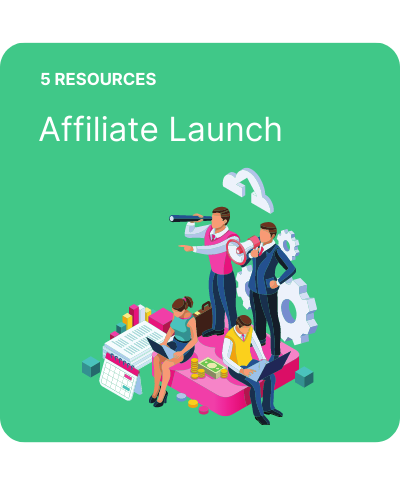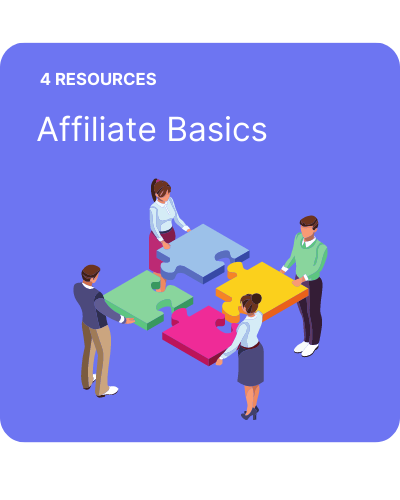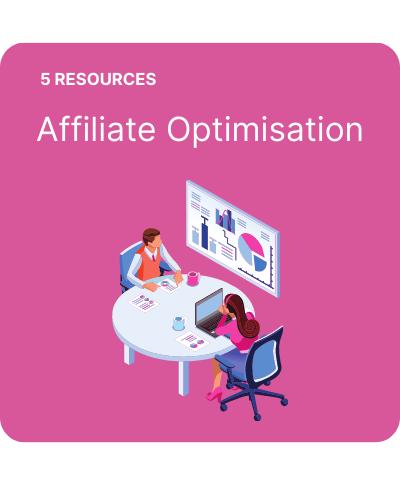How to find new affiliates to recruit
Affiliate recruitment is one of the foundation strategies for any successful affiliate program.
For a healthy affiliate program to thrive, it needs to recruit affiliates before launching. Then once live, maintain a recruitment strategy for the duration of the program.
As you imagine, scouting the internet for prospective partners to promote your program can also be very time-consuming.
I have personally launched, managed and grown many different affiliate programs in various verticals. So, have learnt some techniques on effective recruitment along the way.
Today, I’m bringing you a comprehensive list of affiliate recruitment strategies you can apply to your program.
Now, not all the recruitment tactics below will be relevant to every affiliate program. There are tons of ideas on the list. With a little tweaking, I’m sure there will be at least 10 or 15 ideas you can start using straight away.
1. Affiliate Page
A no-brainer for every affiliate program is to have a page on their site that gives an overview of their program. Make sure you link to it in your footer so it is easy to find and add a link to your affiliate sign-up page.
Some affiliates might have an idea of what and who they want to promote but haven’t approached the network yet. You want them to know about your program and sign-up instead of with your competitors.
2. Affiliate Profile
A network profile is completed upon launching your program with any network. Make sure it is inviting and gives a good overview of the program.
If need be, take a look at other profiles for brands in your vertical or with similar audiences and pick out the key information they are referencing.
3. Checkout Page
Your customers are some of the best ambassadors for your brand. Post-purchase, why not have information about how they can easily earn commission from talking about your brand.
Why not make it even easier and have a suite of widgets that they can easily populate with their content or links and share on social media. The process for promoting you should be as frictionless as possible, especially for someone with limited affiliate knowledge.
4. Niche Websites
Part of any recruitment strategy would be finding websites in your niche that would make great affiliate partners.
If a website is already talking about your products or similar products, then naturally they should be recruited. To do this at scale you may need to use an online tool as reaching out and following up can be time-consuming.
5. Brand Partnerships
Brand partnerships are seeing a lot of popularity within the affiliate industry as a way to drive sales but they could also be used for recruitment.
By working with a non-competing brand that might have synergy in terms of the audience you are opening up to a potential new customer base. What you promote could be an offer, a free product or a chance to earn a side income through affiliate marketing.
6. Attend Conferences
Conferences within the affiliate industry will not always be advertiser and supplier facing. Companies that host conferences will reach out to publishers to attend and get a chance to mingle with other industry individuals.
Some key affiliate industries include Affiliate Summit, DMEXCO and the UK based PerformanceIn Live.
Outside of affiliate conferences find digital marketing conferences where a publisher might be. SEO is a great example as all sites need a grip on this to be successful.
An SEO conference could have a wealth of sites that you could get to know and recruit to your program.
7. Network Events
Most major networks will put on at least one event every year. It is a chance for them to educate brands and publishers on their tools and give an overview of their plans for the future.
There will be a mix of network staff, agencies, program managers and affiliates at these events. Seek out the affiliates and introduce them to yourself and your program.
8. Influencer Events
Affiliate networks have spent a lot of resources going after influencers and recruiting them to their networks.
From my personal perspective, a lot of these influencers haven’t been educated on affiliate marketing and need some guidance to get started.
Bypass the networks completely and recruit directly from an influencer event. That way you can hold their hand through the onboarding process and make sure they promote your brand.
9. Brand Events
I have always felt that brand events are a great way to engage people with who you are as a company.
Those that are in support of your brand are more likely to promote you. Create a sense of community around your program and you will see more partners actively talking about your brand.
10. Customer Emails
Adding a sign-up element post-purchase is a tactic for any new or repeating customers once it goes live.
But, if you are convinced about your customers being brand ambassadors and ideal affiliates. Why not send a communication out to your entire customer base.
You might want to make this approach a bit more subtle. In that case, keep your communications the same. But, add an element towards the bottom of the email informing them of the program.
11. Brand Blog Posts
Most sites have a blog live. Typically this is an afterthought and content can sometimes be lacking.
Take the opportunity to relaunch the blog as a way to talk about your affiliate program. Showcase the partners you work with and cross-promote their original content in your blog posts.
12. Videos
Video has become one of the best ways to consume information across the website. Whether it be longer content on Youtube or shorter edits on the likes of TikTok or Instagram.
Harness the desire from viewers for engaging content by creating videos. These could be affiliate guides or a breakdown of your latest styles or bestsellers. Either way, ensure you are mentioning your affiliate program in some way to encourage sign-ups.
13. Podcasts
Talking with seasoned experts on a podcast can boost your profile in a particular industry. It will also bring awareness of your program to listeners.
A lot of affiliate podcasts will have a mix of listeners, both publisher and advertiser side. If they have taken the time to listen to an industry podcast, then I would say they are a pretty serious affiliate marketer. Which would make for a strong partner to have.
14. Affiliate Directories
A slightly old school way of getting your program out there, it can still be effective. You are listing your program and its benefits in front of affiliate marketers looking for the next great program to join.
Some of the older affiliate directories have closed down, but you should still be able to list on the likes of 100 Best Affiliate Programs and Affiliate Seeking.
15. Ask Affiliates To Recruit
Just like how your customers are great ambassadors for your brands, so are your affiliates. They are already on your program and earning a commission.
Offer your affiliates the chance to recruit new affiliates onto your program and reward them for doing so. You might want to offer them a bonus for everyone they recruit or a two-tier commission whereby they earn a percentage of the new affiliates commission.
16. Social Media Groups
There are loads of social media groups out there for all different types of topics. You could use any of the below as ideas for topics that could provide affiliates
- Affiliate marketing group
- Side hustle
- Make money online
- Vertical specific (e.g. sneaker enthusiasts)
- Affinity audiences
Don’t just jump in and start spamming away. Every group will have rules to follow, make sure you are engaging with members and having valuable conversations before selling your program.
17. Mobile Apps
Don’t ignore apps as a way to get in front of customers through an affiliate partnership.
If you sell some kind of financial services and there is an app for managing your budget. I would say they would be a great app to recruit as an affiliate.
Take a look through the app stores and find apps that might have an audience that you could turn into customers.
18. Network Ads
Some networks allow brands to push their program to potential affiliates through ads. This could take the form of side ads in a blog post or preferred results in the search area.
Ask your network representative for more information as there might be some minimum requirements from them to get involved.
19. Site Backlinks
By using a third-party tool like SEMRush you can gain valuable insight into the websites currently sending backlinks to your brand.
Start with those with the highest domain ranking or traffic driven and ask them to turn that backlink into an affiliate link.
They might not even be aware of your affiliate program and jump at the chance to earn some commission from an old link.
20. Social Content
Tools like BuzzSumo give you information on articles that have a high social sharing number around a particular niche or keyword.
As a beauty brand, you could search ‘make-up’ and find a ton of articles with a big social share. You can then target the site that published the article and ask them to join your program.
Large social shares are a strong indicator of an engaged audience that values the opinion of those writing the article.
21. Competitors Backlinks
You could use SEMRush not only to monitor your own traffic but also to see who is linking to a competitor.
Anyone who is linking to your competitor through a standard or affiliate link is someone I would immediately be getting in touch with to join my program.
22. Network Blog / Communications
When your program launches on the affiliate network ask to be included in their upcoming communications.
Networks will have a blog that they can include you in. Also, they often send roundup emails of new or popular brands on their network.
23. Influencer Networks
Since influencer marketing became such a successful tool for many brands to create more orders it has sprung up a ton of influencer networks.
These influencer networks pull in data from social and offer brands a way to contact influencers and possibly work with them.
For the cost of a free product or a small tenancy fee, you could get your brand promoted by a ton of niche influencers. Every influencer you work with is then an ideal affiliate as part of a longer business partnership.
24. Social Ambassadors
Track the conversations people are having about your brand on social. Those with positive things to say could be worth reaching out to especially if they have an engaged and loyal following.
They could basically just earn a commission for the conversations they are already having about you.
25. Press Releases
Lots of sites still use press releases as a source for content. Tap up your PR team or plug into the press release sites yourself to introduce your affiliate program.
It only takes time to write the press release and could result in getting your program in front of hundreds of websites.
26. Content Hubs
Beauty brands do a great job with content hubs. It is branded as a community for lovers of the brand to hang out and there is a lot of user-generated content on there.
Content hubs are ideal places for affiliates to get company and product information about the brand. So, use it as a recruitment tool as well.
Join the ‘brand x’ community and earn rewards – i.e. sign-up to the affiliate program.
27. Sub Networks
We often recruit affiliate sub-networks onto our program and leave it there. But, we need to be promoting our program through the sub-network to gain traction.
Some sub-networks will include you in emails (but may want a higher commission). You could bypass slightly by uploading your offers into the program. These offers get included in emails and drive engagement without directly calling the brand out as a program to promote.
28. Blogger Networks
Blogger networks like RewardStyle allow you to promote your brand or products to their user base of the best bloggers.
Depending on your commission plan with them you get access to email sends and social notifications to their bloggers. As a fashion brand, this would be an ideal way of raising your profile to the perfect audience.
29. Affinity Sites
Affinity sites are places across the internet where your customers might spend their time but aren’t directly linked to your vertical.
For example, a watch brand might focus a lot of attention on fashion sites. But watches are typically an investment for those that have a bit of money. So, take a look at finance sites, a place where your audience might be consuming content.
30. Website Affiliate Declarations
This is more of a side note than a driver of recruitment. But, post-GDPR it is important for sites to declare whether they receive a commission from any links in their articles.
If there have a declaration header before their articles or in the sidebar there is a good chance they are an affiliate.
I don’t believe there is an easy way to do this at scale. Just one to be mindful of when you are spending time visiting sites.
31. Chrome Plugins
A lot of plugins in Chrome are free. Which means they need to make money through advertising revenue. The default is normally some kind of Adsense.
Like with mobile apps, look through the plugin store and find those with a good install history and user base. Get in touch and see if you can secure an affiliate partnership to advertise to their users.
32. Paid Ads
This could get costly, so be careful. But, if there is money in the budget, why not invest in some paid ads to recruit affiliates.
Manage the budget closely and I would say work everything but to an acquisition cost. Formulate how much you are willing to pay for every new affiliate and stick to it.
34. Forums
I mentioned before how you could target groups on social but there are also forums. Like with groups don’t just focus on your niche and assess all ways to target, paid or not.
You may find some are behind a paywall and you need to weigh up whether it is worth it. Although, those behind paywalls typically have a more engaged community.
35. Guest Blogging
There are thousands of sites out there talking about how to make money online. Guest blog on one of the sites and spin your article around your brand or vertical.
You could make your article about how to make money promoting fashion brands or how to make money with a savings site. Remember to plug your program and the article should drip-feed affiliates looking to make some money promoting a brand like yours.
36. Comment Sections
Make sure to follow up on any guest blogging you take part in or find other relevant sites. Good websites will have an active comment section and could have affiliates posting questions.
You want the program to show it has active account management so reply to any comments in there and offer any additional advice.



